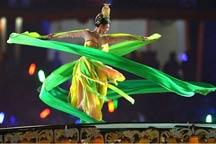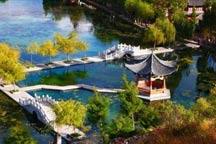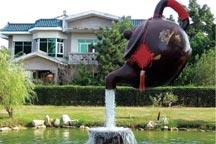On this episode of Travelogue, hear the songs of the Dong people echo through the mountains of Guizhou, recounting tales of their culture and history.
Variety of its landscape and diversity of its people, welcome to Travelogue’s ethnic minority special. Among the beautiful songs and amazing scenery, and the Dong village. We are in Guizhou to learn about these unique peoples. I’m Yin and come with us as we welcome you into Guizhou, cheers.
Nestled among the mountains of Guizhou we find countless villages that are home to the vast majority of the Dong ethnic group. Under these black tiled roofs live a people who have preserved their unique traditions from over 2,000 years ago.
Their home, Guizhou, is a multiethnic province in southwest China. We will travel through this area of mountains and hills to the Dong villages of Liping.
The Dong people are said to have three treasures: one is their drum towers, another is their wind and rain bridges, and the third is the Dong chorus.
Music and song are an important and omnipresent component of Dong culture. People are likely to burst into song while working in the fields or doing the housework, as well as on special occasions. According to Dong tradition, important guests must be greeted in song. All of which makes a Dong village a rather lively place.
After two hours of twisting mountain path, we’re finally here. And if we look down here, you will see the village tucked underneath the mountains, within mother nature. I think I hear some music, maybe the people down there are greeting us.
The warmest welcome is a greeting with music and homemade rice wine. You can’t have one without the other, so get ready to drink up!
So, there are some people blocking my entrance into the village, but I’m going to get in anyway. So I have to sing with them. Mary had a little lamb, little lamb. So I have no choice. So now I can cross because I drank.
Zhaoxing is the Dong’s most beautiful, largest, and best-preserved village. This is certainly a must-see stop, surrounded by mountains and crossed by a river.
In fact, Zhaoxing has even been included in the Guinness Book of World Records, because of the purity of its ethnic culture.
The wooden houses are usually two or three storeys high. Those located on steep slopes or by the river stand on stilts. People live on the upper floors, while the ground floor is reserved for the animals and firewood. There’s little sign of the modern world taking hold in this town. The villagers still live in their old wooden houses, and they still wear their traditional costumes. The lifestyle hasn’t changed much, either. During the day, the men and women do the farm work, the elderly do some weaving, and children dabble in the water. Families here tend to be self sufficient, in that they grow their own crops, catch their own fish and raise their own livestock.
The natural environment is involved in everyone’s life here. This plant is green, and after it is drenched in the water for a long time, it becomes something like this. This is actually a dye for peoples clothing, and you see what originally is this color, after usage for the cloth has a purple-ish blownish tinge,
People here make their own clothes. The women are kept busy, dyeing the fabric and weaving – either in the street, or on machines indoors
Zhaoxing is divided into five sections. Each is denoted by a single character, meaning benevolence, justice, courtesy, wisdom, and faith. Each section is occupied by a distinct community, with its very own drum tower.
Their drum tower, so the Dong believe, is an auspicious building that protects them. It’s built in an octagonal shape, and decorated with carved dragons, phoenixes, flowers and birds.
The drum tower is the symbol of a village, and a reflection of the craftsmanship of the people living there. The most skilled villagers get together to build the tower. They design it in their heads, without the aid of pen or paper. But most incredible of all, not a single nail is ever used in a drum tower.
The tower gets its name from the drum hanging from the ceiling, which is beaten to summon people together. In this sense, the tower is the centre of Dong life. The ground floor serves as a public hall for meetings, social gatherings, and even recreation.
There’s a play going on. The drum tower area besides being a meeting place for officials and others to discuss affairs also became a place for entertainment. So if you come at the right time, you might be able to catch the Dong opera.
Dong opera has a long history. It’s closely associated with people’s lives. Music and song are an important means by which these people express themselves. Their history has been handed on from one generation to the next, orally.
The performers are all local amateurs. They perform to entertain others as well as themselves. Remembering the lyrics can be difficult, so the backstage prompt has a vital role to play.
It’s the drum tower behind me. These Dong villages are amongst natural landscape, like over here, you can find nice clear flowing waters and the wind and rain bridge. This is one of the most characteristic of the local Dong village. And my favorite, amongst the grand landscape here, you have wooden houses, and hills and mountains in the back. To make things better is I’m actually staying here tonight. Not bad. Simple, clean, I could stay here for tonight. Look at that scenery. It appears I have some neighbors around me as well. Many decide to stay for more than a few days to experience the real Dong life. Even the chef is not employed by the apartment, just a local guest. Whoever wants to show off their skills. I can enjoy this for a few more days.
At night, we see another side of Zhaoxing village. It’s a place mixing past and present.
In this quaint bar, in this old village, the furnishings and music are ethnically Dong, but the people are from every corner of the world. The wine, the mystical lights ... It’s an exotic blend of artistic creativity.
Dong people typically build their villages on rivers, so bridges are essential. Every village, whether it’s large or small, needs these special structures known as wind and rain bridges. We take a trip to a village called Sizhai to visit one particularly beautiful bridge. The bridges are sometimes known as "flower bridges", because of the exquisite sculptures and frescoes that cover them. The longest bridges, which are over 76 meters, are like huge dragons stretching across the water. And there’s nothing like sitting on a bridge on a sunny day and chatting with a few new friends.
The wind and rain bridge is an interesting characteristic of the Dong village. They are called so because you see this roof, it protects you from the rain and wind. Besides serving as just the bridge, it serves as a form of art. This is a picture of the local people going about their daily lives. They have umbrellas with them, so I suppose this is before they had the wind and rain bridge. Over here you see a different sight. The man and woman are under the tree, near the bridge, playing a local instrument and courting the female.
The young men and women gather on the bridge to sing to each other. In their songs, they quite openly express their emotions and feelings.
Feeling shy? Here, dating is not just a two person deal. Instead, both parties bring their friends! Their voices echo in the mountains.
Next, we’re on the road to Huanggang, where shelter is provided by wooded mountains above meandering streams. Here, we find the most pristine of Dong ethnic culture. SLOW The journey has plenty of natural barriers, yes, but it’s certainly worth all the effort. Although transportation across Guizhou is becoming more convenient these days, places like Huanggang still retain their air of mystery.
Guizhou, the home of the Dong people, remains largely a hidden treasure compared to its neighbours Yunnan and Sichuan, both of which are top tourist destinations. And of all the places in Guizhou, there are few more remote than Huanggang, which is unlisted in guidebooks and on most websites. Because of the relative geographical isolation of China’s southwest, the Dong people have had little contact with the outside world. Huanggang preserves the age-old traditions of this little known ethnic group, whose history dates back to the Qin and Han Dynasties over 2,000 years ago. SLOW The people here are superb musicians, fabric makers, and architects who spend their entire lives in their village.
In this remote location, it’s no surprise to find that animistic religious beliefs and practices are still alive and thriving. People believe in the existence of benevolent and malevolent spirits in Nature. Rocks, rivers, mountains, bridges – all have spiritual significance and are considered holy. The small village of just a few dirt roads is a place with unique charm and wholly different from anything I’ve ever seen before.
Nowadays, most cultures pass down their traditions and history in a written language; in other words, in books. What the Dong people pass down from one generation to the next is songs. In the areas where the Dong live, no one is more respected than a fine singer. A good voice is a sign of intelligence and wisdom. The fact is, the singers are the local historians – living encyclopedias.
I heard from the locals that there would be a grand song lesson today. So, I decided to check it out myself. To my surprise, it’s little youngsters taking lessons.
Since childhood, the Dong learn to sing the special songs of their people. This is an essential part of their education. The songs are a part of their heritage that reminds them of their past, and in doing so, gives them direction for the future.
And the formal arena for performing songs in the village, is the drum-tower. Families, even entire villages, sing together, particularly on festive occasions like holidays and weddings, and to welcome guests.
The most popular form of song is the 'grand song'. This is generally a narrative, whose major themes range from love stories to episodes from history, and even lessons in morality. It is only by listening to the grand song that we can begin to understand the beauty of Dong culture. And the men and women singing together in harmony capture the sense of unity in the village.
So important is the drum tower, that when a village is being built, it’s the first building to be erected. The drum tower’s value is partly symbolic. But it is practical, too. Traditionally, important activities are held in the drum-tower, such as general councils, meetings to write up the village by-laws, and court sessions to settle disputes and lawsuits. The drum tower also houses the one item that is perhaps the most important in all the village. Its drum.
The head of the village is in charge of the drum. If the drum is beaten, everyone will gather at the tower. The tower is the place to discuss community affairs – rather like a 'town hall.' Traditionally, meetings are attended exclusively by the men. Maybe something big will happen today, as all the men have arrived. It looks like some important guests are visiting the village.
So as a local villager in my local gear. I am ready to greet into the village. To enter the village, you have to pass the area here. How do you do that? You have to either drink or sing. Let’s see what they will choose?
Indeed, it’s a really festive occasion. All the villagers are ready, and everyone is dressed in their finest. From their costumes, we can tell how diligent all the women in the village are and how creative they are as artists. One of the criteria a Dong man looks for in a prospective wife, is her proficiency in embroidery, dyeing and weaving.
And the alcohol begins. Nobody is off the hook and this is the warmest greeting we could possibly give. There is a special ceremony for all the vips, who make special contributions to the village. You sit on the sedan chair and in the village.
Typically, the ceremonies are held for the town elders who have made a great contribution to the village, or for people from other villages who visit – like the crew of CCTV9’s Travelgoue. The ceremony expresses thanks to these people. It involves music, songs, and a sedan chair ride around the village, from one drum tower to the next. This is the warmest welcome I’ve ever received. An entire village of men, women, children, and elders, all crowding round to join in the excitement. It’s amazing – and the ceremony is certainly no less impressive than a walk on a red carpet!
And what better way to honour guests than with an evening feast!
The local food tends to be salty and rather sour, with a staple of glutinous rice. Dinner is a communal activity, with the entire village sitting together near the benches in the drum tower.
Usually at one of these gathers, the people don’t start eating until the elders have started. And I think they have, so we’re going to get started, but first the chopsticks are only used for the vegetables. The main course, the rice here, you have to use your hands, like that.
Although the flavour of the food is not something I’m used to, the lively spirit of the community is something I can really appreciate.
For the Dong, nothing goes better with a good meal, than a good drink. Most men here are very fond of a drink. They make their own rice wine. The flavour is pretty strong, as if it’s richly filled with emotion.
At the dinner table, you can sense the warmth and passion of their nature. Once again, of course, there’s singing – the chance to reveal their innermost feelings. They believe here that rice is for the body, and song is for the soul. Surrounded by their cheerful songs and heartwarming smiles, I truly feel like I am amongst the most pure-hearted of company. Although we are from seemingly different worlds, tonight we are one.
Their drinking culture is very important to the Dong people. They drink wine at every meal, men and women alike. I’m not a big drinker, but you simply can’t refuse these people.
I have no choice, see you tomorrow morning.
At the end of the day, the sun sets, everything is quiet, and the people return home to the villages on top of the mountains, isolated from the modern world. Few people ever get to learn about the Dong people. So I hope you’ve got maybe just a small glimpse of their unique lifestyle on today’s Travelogue. I’m Yin, and see you next time.
Tips:
The Dong are a minority with a history of over 2000 years, living in the mountainous regions of Guizhou.
The Dong are famous for their drum towers, rain and wind bridges, and the Dong chorus.
The Dong people are warm and kind-hearted, greeting visitors with song and local wine.
 2009 China Central Television. All Rights Reserved
2009 China Central Television. All Rights Reserved

















